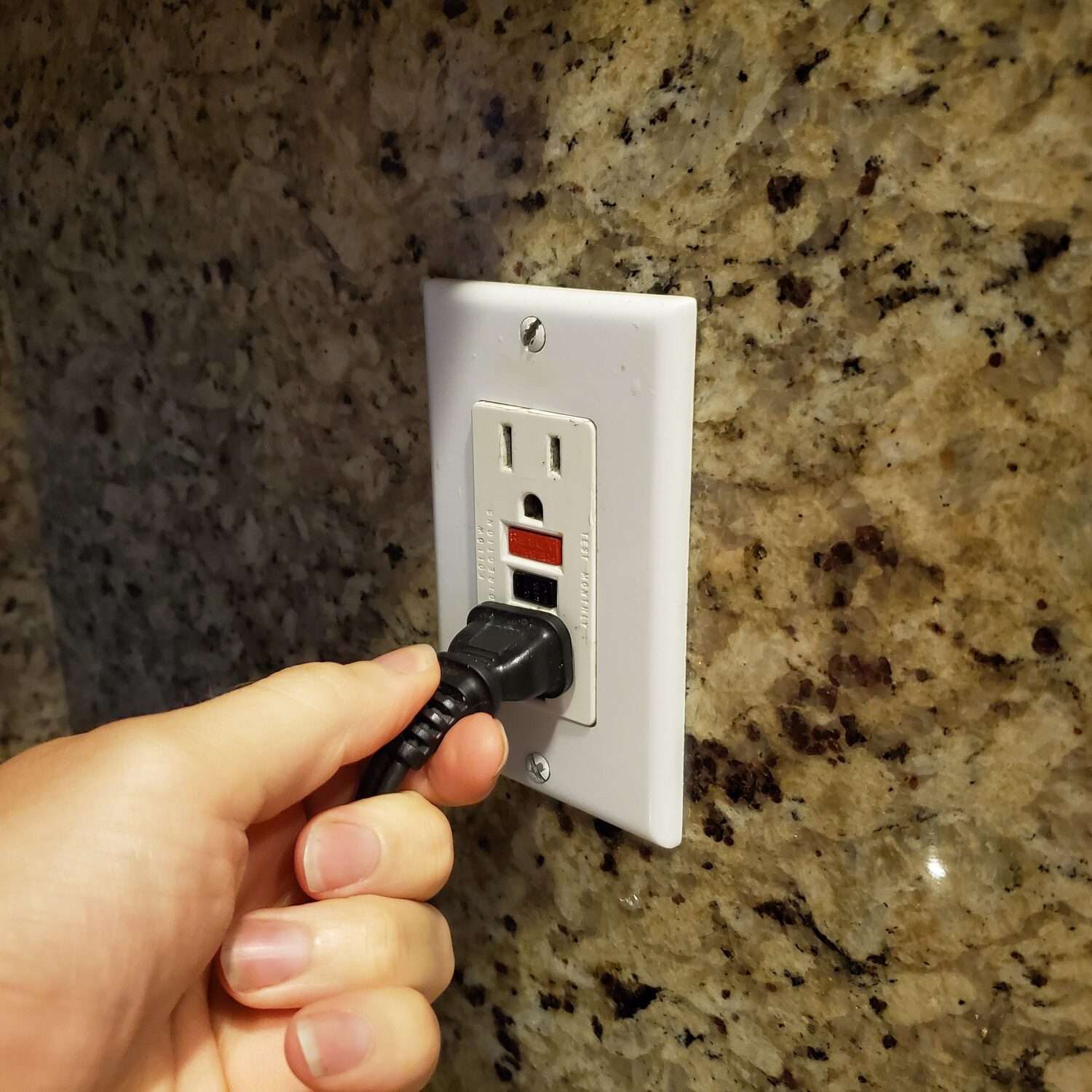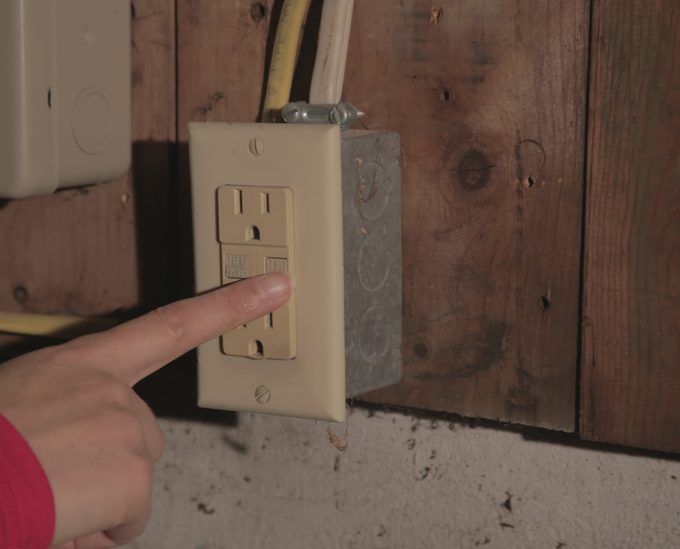Unlike the last test you took in school, this one is fast and easy—and protects you from harm. An electrician explains.

This 5-Second Household Test Could Save Your Life—Here’s What to Know

Think about your morning routine: Do you hop out of the shower and immediately reach for the blow-dryer? Plug in a hair straightener as you brush your teeth? You likely know that water and electricity don’t mix, but you’re probably not aware of the other risks your electrical outlets pose. If you were, you might be asking a different question: How do we manage to survive our daily routines with all these hidden dangers?
The answer lies in a ubiquitous little safety device that you probably never notice but that has been required in bathrooms since 1975. In fact, these devices appear in multiple locations around your home, and as an electrician, I can tell you they are lifesavers. When I was an apprentice, I managed to get a nasty shock that sent me to the hospital (I am fine!), a scary situation that could have been prevented with proper equipment.
What are these devices, and what should you add to your home-maintenance checklist to make sure they’re in working order? Ahead, I’ll explain how they keep you safe and walk you through two easy methods for testing these critical tools.
Get Reader’s Digest’s Read Up newsletter for more home tips, humor, travel, tech and fun facts all week long.
What test should you add to your home-maintenance checklist?
To keep your family safe from electrical shock, you should check your GFCI outlets, more properly called “receptacles,” on a regular basis. In the United States, approximately 1,000 deaths and at least 30,000 nonfatal electrical shock incidents occur every year, with 20% of those victims being children. Testing the GFCIs in your home is a simple, cheap and fast way to make sure no one in your family ends up as a statistic.
What are GFCI receptacles?
These are the square-faced receptacles in your bathroom, kitchen and other rooms in your home (and outside it) where water is likely to be present. The term GFCI stands for “ground fault circuit interrupter.” These important safety devices monitor the electricity being used by whatever is plugged in; if the GFCI senses an imbalance that could result in a dangerous shock, it “trips” (shuts off the power) almost immediately.
If you don’t see square GFCI receptacles in your bathroom, kitchen or other required locations, you likely have some protection—unless your house hasn’t been updated or sold in more than 50 years. The National Electrical Code (NEC) allows GFCI receptacles to protect “normal” ones (the roundish everyday outlets you have throughout your home) on the same circuit, and special circuit breakers can also provide GFCI protection. The NEC continually updates GFCI safety requirements, so if you’re worried, verify any questions with an experienced electrician.
Pro tip: If you ever have a receptacle that suddenly stops working, look for a GFCI somewhere else in your home: another bathroom, the garage, the basement or outside. It’s possible that you just need to reset that GFCI for everything to start working again.
Why do you need to test your outlets?

It’s important to test your GFCIs because you want them to work when you need them! GFCI receptacles have both electrical and mechanical components inside, and any of these intricate workings could fail due to age or malfunction.
Manufacturers recommend testing GFCIs regularly. While they have a long (if variable) lifespan—10 to 25 years—testing them gives you a chance to remedy any problems before it’s too late.
What can happen if you don’t test your GFCIs?
It might sound dramatic, but your life could depend on a working GFCI. To understand why, I’ll provide a little background first.
The electrical circuits in your home are measured in amperes (aka amps), which describe how much current the circuit can safely deliver. Most of these circuits are either 15 or 20 amps, and the appliances and devices you plug into them can use all or some of those supplied amps. For example, a blow-dryer uses nearly all of the circuit capacity, while an iPhone charger uses very little.
But here’s the thing: It takes only 0.1 to 0.2 amps of electricity to seriously injure or even kill a person—a tiny fraction of the capacity of your circuits! (If you’ve heard differently, that’s an electrical myth.) Water makes the problem worse because it conducts electricity. If something goes wrong with your blow-dryer or an outdoor extension cord, you could get a dangerous, even lethal, shock.
GFCIs are designed to trip at 0.004 to 0.006 amps, which is much lower than the typical danger threshold.
How often should you do this test?
Test your GFCIs monthly.
If that’s news to you, you’re not alone. Most people never test their GFCIs. In fact, they’ve been so historically neglected that the standards organization UL, which certifies the safety of GFCI production, started requiring manufacturers to include an internal self-test function in 2015. If your home was built or rewired in 2015 or later, it’s likely you have self-testing GFCIs—but you should still manually test them yourself.
Why? Well, the internal self-test checks the electronics (and will indicate failure with a light or alarm), but it can’t test the physical buttons and mechanical contacts. So manufacturers recommend testing monthly even if your GFCIs are newer.
How do you test your receptacles?
Testing your GFCI receptacles couldn’t be easier, and you can do it in five seconds or less.
Before you get started, familiarize yourself with the front of the GFCI receptacle. You’ll see two buttons, Test and Reset, and one or more indicator lights, depending on the device’s age and manufacturer. The light may be green when on and ready, yellow for test mode and red for a problem or failure, but again, this could vary.
When testing, you should hear an audible click, the power should shut off and the reset button should pop out and be resettable. If your GFCI does not respond or reset, or if you see a red warning light, your GFCI or wiring may be faulty.
Here are two easy and safe ways to check GFCIs.
Use the buttons on the receptacle
This method requires no special tools or gadgets and is the most common way to check GFCIs. It’s also the method that manufacturers recommend because it’s safe, easy and reliable for electricians and non-electricians alike.
Tools:
- Small lamp or radio
- Wooden chopstick (optional)
Steps:
- Plug in a small lamp or radio, and turn it on.
- Note the state of any indicator lights on the GFCI.
- Push the Test button on the GFCI. Sometimes GFCI buttons are hard to push; if so, use a wooden chopstick—never anything metal! You should hear an audible click, the lamp or radio should shut off, and the indicator light, if present, should change.
- Push the Reset button until you hear a click and the lamp turns on.
- Verify that any indicator lights on the GFCI have reset to their original state.
Use a GFCI tester
This method for checking GFCIs should not be your primary testing method, but it can be a useful tool as a secondary check because it helps diagnose wiring issues. It’s also helpful when testing regular (non-GFCI) receptacles that are protected by a GFCI in another location. This method is not suitable for older homes without modern, grounded (three-prong) receptacles.
Tools:
- GFCI receptacle tester
- Wooden chopstick (optional)
Steps:
- Plug the tester into the receptacle. If the receptacle has power, the tester will light up and indicate if the receptacle is properly wired. (If the lights show a problem, stop and consult an expert.)
- Push the button on the tester. The lights should go out, and you should hear an audible click.
- Remove the tester.
- Push the Reset button (with your finger or a chopstick) to reset the GFCI.
- If you tested a regular receptacle that is protected by a GFCI in another location, find the GFCI that tripped (by testing your GFCIs) and reset it.
What do you do if your GFCI receptacle fails the test?
No matter what method you use to check GFCIs, if one fails to trip (shut off) when conducting the test, or if you’re unable to reset it by pushing the Reset button, it needs to be investigated or replaced. If you or someone in your family is handy and comfortable working with electricity, checking connections or replacing a GFCI is a doable DIY task.
But remember what I said earlier: It takes only a fraction of an amp to kill or injure a person. If you do not know what you are doing, it’s best to call a pro.
Why trust us
At Reader’s Digest, we’re committed to producing high-quality content by writers with expertise and experience in their field in consultation with relevant, qualified experts. We rely on reputable primary sources, including government and professional organizations and academic institutions as well as our writers’ personal experiences where appropriate. We verify all facts and data, back them with credible sourcing and revisit them over time to ensure they remain accurate and up to date. For this piece on how to check GFCI, Ally Childress tapped her experience as a professional electrician and home-improvement writer. Read more about our team, our contributors and our editorial policies.
Sources:
- Independent Alliance of the Electrical Industry: “The History of GFCI Protection in the NEC”
- National Fire Protection Association: “NFPA 70, National Electrical Code”
- National Institutes of Health: “Electrical Injuries”
- UL Solutions: “GFCI Personal Protection Devices Testing and Certification”























